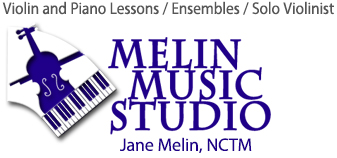As you progress into the last 4 ASTA Levels, the technical challenges advance substantially. You will need to play extended fast passages evenly and cleanly; encounter double-stop passages more often in pieces; shift fluidly and quickly into and out of high positions (5th and above); master more difficult bowing skills including fast spiccato, sautille and complex string crossings. All basic foundational skills should be mastered (playing with straight bow, good hand/arm/finger technique), with ever-improving intonation and confident, constant vibrato. 12-15 months is not too long to expect to be working on completing each of these levels; it will depend greatly on how much time you spend in focused practice.
- Baroque repertoire in the advanced levels often has extended double-stop passages featuring counterpoint (2 melodies playing at once). These pieces will help prepare you to play the Bach Unaccompanied Sonatas and Partitas that are core repertoire at the top 3 levels.
- You’ll notice a lack of much repertoire from the Classical period at Level 7. The major Mozart and Beethoven violin concerti and sonatas are at Levels 8, 9 and 10.
- Romantic advanced repertoire often consists of show-pieces composed to spotlight the violinist’s technical skills. Sometimes the musicality of the piece can be overshadowed by the showoff factor. Be sure you choose pieces that appeal to you melodically, or have technical flair that you would like to learn to play (such as gypsy-style), or you may grow tired of working on the piece before you have mastered it.
- Selections from the Contemporary period often feature complex harmonies and dissonances. It is good to explore this music to broaden your horizons and prepare for orchestral playing or auditions; choose at least one piece between now and Level 10 in this genre.
Requirements:
One substantial piece or fast concerto movement (List A) and one short contrasting piece from a different period (List B); OR 3 pieces from list B from at least 2 time periods. All memorized. Pieces marked with * or ** are considered core repertoire; choose at least one piece that has a */**.
**These are Mrs. Melin’s favorites from the core repertoire.
List A: Major Works CHOOSE ONE
Baroque Period
**Bach Concerto in Am (1st or 3rd mvt.)
*Handel Sonata #1 (play 2 movements, at least 1 fast)
*Handel Sonata #2 (same req. as above)
Tartini: Sonata in Gm
**Vivaldi: Spring from The Four Seasons (either 1st, or 2nd+3rd mvts.)
Classical Period
*Mozart: Concerto #2 (first or third movement)
1st mvt 3rd mvt
(You will be able to play Mozart’s Violin Concerto #3 at Level 8; this is highly recommended and worth waiting for unless you’d like to play 2 Mozart concertos in a row)
*Schubert: Sonatina in D for violin/piano (Play 2 movements, at least one fast)
Viotti: Concerto #23
Romantic Period
**Monti: Czardas and another demo video …
Rieding: Concerto in E minor
*Ten Have: Allegro Brilliante
List B: Secondary Works CHOOSE ONE, from a contrasting period to List A piece (or, choose 3 if no List A piece; at least one must be a fast tempo)
Baroque Period
**Bach: Arioso
**Bach: Air on the G String
Desplanes: Intrada
Classical Period
Gretry: Tambourin
Schubert: The Bee
Romantic Period
**Gluck/Kreisler: Melodie from Orpheus
**Massenet: Meditation from Thais
D’Ambrosio: Canzonetta
*Kreisler: Liebesleid
Wieniawski: Kujawiak
Contemporary Period
Ibert: Little White Donkey
Kreisler: Syncopation
Martinu: Five Madrigal Stanzas http://www.youtube.com/watch?v=QL-IqiF3_TI or http://www.youtube.com/watch?v=4kHDi9ydOLc (Two of the five)
O’Connor: Limerock
O’Connor: The Cricket Dance
